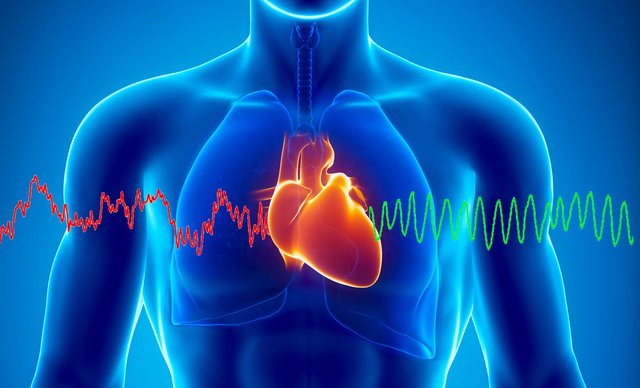|
Cardiovascular Health and Your Breathing
Primary hypertension (also called essential hypertension or idiopathic hypertension) is the form of hypertension that by definition has no identifiable cause. It is the most common type of hypertension, affecting 95% of hypertensive patients.
Untreated hypertension is a risk factor in heart attack, heart failure, stroke, eye damage and kidney failure.
Conventional treatments focus on lifestyle modification and antihypertensive drugs.
Lifestyle modification may include:
- Stress reduction
- Dietary approaches
- Increased physical activity
- Limiting alcohol consumption
- Smoking cessation
- Sodium reduction (≤2.4 g/day) *
Hyperventilation, hypocapnia and cardiovascular health
Breathing in excess of normal metabolic requirements causes a loss of carbon dioxide (CO2) from the blood, leading to hypocapnia. Hypocapnia alters oxygenation of the heart and cardiac rhythm.2
Reduced arterial CO2 affects cardiac functioning in three ways. Firstly, it reduces blood flow to the heart. (Kazmaier, Weyland & Buhre;3 Neill & Hattenhauer;4 Foex & Ryder5) Secondly, the bond between red blood cells and oxygen is strengthened, leading to reduced delivery of oxygen to the heart muscle (Bohr Effect).5 Thirdly, there is increased oxygen demand on the heart attributable to myocardial contractibility6 and blood vessel constriction.7 (Okazaki, Hashimoto, Okutsu & Okumura)8
In short, over-breathing can potentially contribute to high blood pressure and atrial fibrillation putting you at increased risk of heart attack or stroke. It is no surprise that snoring and sleep apnoea, symptoms of chronic hyperventilation, are risk factors in cardiovascular disease.
What can you do?
In addition to lifestyle factors, research and clinical evidence indicate that over-breathing is a significant factor in cardiovascular disorders. There is a clear relationship between over-breathing and cardiac arrest and heart attack. Follow this link to an article that explains the science linking dysfunctional breathing with cardiovascular disorders. It also documents research to date on the effectiveness of breathing retraining programmes in lowering blood pressure, pulmonary rehabilitation and reducing cardiovascular risk.
Our programmes are designed to help restore a functional breathing pattern improving cardiovascular efficiency and helping reduce cardiovascular risk factors.
Contact our clinic to book a consultation or for more information about our programmes.
References and Sources
- http://bestpractice.bmj.com/best-practice/monograph/26/treatment/step-by-step.html
- Gravenstein J. S., Michael B. Jaffe, Nikolaus Gravenstein. P254 Capnography. Cambridge University Press; 2 edition (May 1, 2011)
- Kazmaier, S. Weyland, A. Buhre, W. et al. 1998 Effects of respiratory alkalosis and acidosis on myocardial blood flow and metabolism in patients with coronary artery disease. Anesthesiology 89:831-7.
- Neill, W.A. Hattenhauer, M. 1975 Impairment of myocardial O2 supply due to hyperventilation. Circulation. Nov; 52 (5):854-8.
- Foex, P. Ryder, W.A. 1979 Effect of CO2 on the systemic and coronary circulations and on coronary sinus blood gas tensions. Bulletin Européen de Physiopathologie Respirtoire. Jul-Aug; 15(4):625-38.
- Boix, J.H. et al. 1994; Modifications of tissular oxygenation and systemic hemodynamics after the correction of hypocapnia induced by mechanical ventilation. Revista Espanola de Fisiologia. 50:19- 26.
- Richardson, D.W. Kontos, H.A. Raper, A.J. and Patterson, J.L. Jr.1972. Systemic circulatory responses to hypocapnia in man. Am J Physiol; 223:130812
- Okazaki K, Hashimoto K, Okutsu Y, Okumura F 1991 Effect of arterial carbon dioxide tension on regional myocardial tissue oxygen tension in the dog. Masui. Nov; 40(11):1620-4.
* Sodium reduction is almost always included in conventional treatment plans despite the paucity of evidence for efficacy. Read more »
|
|
| 20 Arthur Street, Freemans Bay, Auckland 1011, New Zealand | Phone +64 9 360 6291 | Email info@buteykobreathing.nz Download our leaflets [PDFs]: Do you suffer from asthma or allergies? » Do you snore or suffer from sleep apnoea? » 
Registered Practitioner / Practitioner Trainer
PRIVACY POLICY
All cartoons courtesy of Chris Slane, Qantas Media Awards Cartoonist of the Year 2010 ©  Site design © e-compass.nz 2015 |



